ZHCSDS9 April 2015 TPS3779 , TPS3780
PRODUCTION DATA.
- 1 特性
- 2 应用
- 3 说明
- 4 修订历史记录
- 5 Device Comparison Table
- 6 Pin Configuration and Functions
- 7 Specifications
- 8 Detailed Description
- 9 Application and Implementation
- 10Power-Supply Recommendations
- 11Layout
- 12器件和文档支持
- 13机械、封装和可订购信息
7 Specifications
7.1 Absolute Maximum Ratings
over operating junction temperature range (unless otherwise noted)(1)| MIN | MAX | UNIT | ||
|---|---|---|---|---|
| Voltage | VDD | –0.3 | 7 | V |
| OUT1, OUT2 (TPS3779 only) | –0.3 | VDD + 0.3 | V | |
| OUT1, OUT2 (TPS3780 only) | –0.3 | 7 | V | |
| SENSE1, SENSE2 | –0.3 | 7 | V | |
| Current | OUT1, OUT2 | ±20 | mA | |
| Temperature | Operating junction, TJ | –40 | 125 | °C |
| Storage, Tstg | –65 | 150 | °C | |
(1) Stresses beyond those listed under Absolute Maximum Ratings may cause permanent damage to the device. These are stress ratings only, which do not imply functional operation of the device at these or any other conditions beyond those indicated under Recommended Operating Conditions. Exposure to absolute-maximum-rated conditions for extended periods may affect device reliability.
7.2 ESD Ratings
| VALUE | UNIT | |||
|---|---|---|---|---|
| V(ESD) | Electrostatic discharge | Human body model (HBM), per ANSI/ESDA/JEDEC JS-001(1) | ±2000 | V |
| Charged device model (CDM), per JEDEC specification JESD22-C101(2) | ±500 | |||
(1) JEDEC document JEP155 states that 500-V HBM allows safe manufacturing with a standard ESD control process.
(2) JEDEC document JEP157 states that 250-V CDM allows safe manufacturing with a standard ESD control process.
7.3 Recommended Operating Conditions
over operating junction temperature range (unless otherwise noted)| MIN | NOM | MAX | UNIT | |||
|---|---|---|---|---|---|---|
| Power-supply voltage | 1.5 | 6.5 | V | |||
| Sense voltage | SENSE1, SENSE2 | 0 | 6.5 | V | ||
| Output voltage (TPS3779 only) | OUT1, OUT2 | 0 | VDD + 0.3 | V | ||
| Output voltage (TPS3780 only) | OUT1, OUT2 | 0 | 6.5 | V | ||
| RPU | Pullup resistor (TPS3780 only) | 1.5 | 10,000 | kΩ | ||
| Current | OUT1, OUT2 | –5 | 5 | mA | ||
| CIN | Input capacitor | 0.1 | µF | |||
| TJ | Junction temperature | –40 | 25 | 125 | °C | |
7.4 Thermal Information
| THERMAL METRIC(1) | TPS3779, TPS3780 | UNIT | ||
|---|---|---|---|---|
| DRY (USON) | DBV (SOT23-6) | |||
| 6 PINS | 6 PINS | |||
| RθJA | Junction-to-ambient thermal resistance | 306.7 | 193.9 | °C/W |
| RθJC(top) | Junction-to-case (top) thermal resistance | 174.1 | 134.5 | |
| RθJB | Junction-to-board thermal resistance | 173.4 | 39.0 | |
| ψJT | Junction-to-top characterization parameter | 30.9 | 30.4 | |
| ψJB | Junction-to-board characterization parameter | 171.6 | 38.5 | |
| RθJC(bot) | Junction-to-case (bottom) thermal resistance | 65.2 | N/A | |
(1) For more information about traditional and new thermal metrics, see the IC Package Thermal Metrics application report, .
7.5 Electrical Characteristics
All specifications are over the operating temperature range of –40°C < TJ < 125°C and 1.5 V ≤ VDD ≤ 6.5 V, unless otherwise noted. Typical values are at TJ = 25°C and VDD = 3.3 V.| PARAMETER | TEST CONDITIONS | MIN | TYP | MAX | UNIT | ||
|---|---|---|---|---|---|---|---|
| VDD | Input supply range | 1.5 | 6.5 | V | |||
| V(POR) | Power-on reset voltage(1) | VOL (max) = 0.2 V, IOL = 15 µA | 0.8 | V | |||
| IDD | Supply current (into VDD pin) | VDD = 3.3 V, no load, –40°C < TJ < 85°C | 2.09 | 3.72 | µA | ||
| VDD = 3.3 V, no load, –40°C < TJ < 125°C | 5.80 | µA | |||||
| VDD = 6.5 V, no load, –40°C < TJ < 85°C | 2.29 | 4.00 | µA | ||||
| VDD = 6.5 V, no load, –40°C < TJ < 125°C | 6.50 | µA | |||||
| VIT+ | Positive-going input threshold voltage | V(SENSE) rising | 1.194 | V | |||
| –1% | 1% | ||||||
| VIT– | Negative-going input threshold voltage | V(SENSE) falling | TPS37xxA (0.5% hysteresis) |
1.188 | V | ||
| TPS37xxB (5% hysteresis) |
1.134 | V | |||||
| TPS37xxC (10% hysteresis) |
1.074 | V | |||||
| TPS37xxD (1% hysteresis) |
1.182 | V | |||||
| V(SENSE) falling | –1% | 1% | |||||
| I(SENSE) | Input current | V(SENSE) = 0 V or VDD | –15 | 15 | nA | ||
| VOL | Low-level output voltage | VDD ≥ 1.2 V, ISINK = 0.4 mA | 0.25 | V | |||
| VDD ≥ 2.7 V, ISINK = 2 mA | 0.25 | V | |||||
| VDD ≥ 4.5 V, ISINK = 3.2 mA | 0.30 | V | |||||
| VOH | High-level output voltage (TPS3779 only) |
VDD ≥ 1.5 V, ISOURCE = 0.4 mA | 0.8 VDD | V | |||
| VDD ≥ 2.7 V, ISOURCE = 1 mA | 0.8 VDD | V | |||||
| VDD ≥ 4.5 V, ISOURCE = 2.5 mA | 0.8 VDD | V | |||||
| Ilkg(OD) | Open-drain output leakage current (TPS3780 only) | High impedance, V(SENSE) = V(OUT) = 6.5 V, –40°C < TJ < 85°C |
–50 | 50 | nA | ||
| High impedance, V(SENSE) = V(OUT) = 6.5 V, –40°C < TJ < 125°C |
–250 | 250 | nA | ||||
(1) Outputs are undetermined below V(POR).
7.6 Timing Requirements
Typical values are at TJ = 25°C and VDD = 3.3 V. SENSE transitions between 0 V and 1.3 V.| MIN | NOM | MAX | UNIT | ||
|---|---|---|---|---|---|
| tPD(r) | SENSE (rising) to OUT propagation delay | 5.5 | µs | ||
| tPD(f) | SENSE (falling) to OUT propagation delay | 10 | µs | ||
| tSD | Startup delay(1) | 570 | µs | ||
(1) During power-on or a VDD transient below VDD(min), the outputs reflect the input conditions 570 µs after VDD transitions through VDD(min).
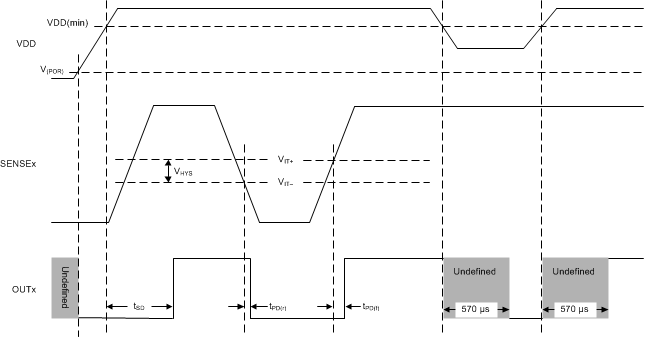 Figure 1. Timing Diagram
Figure 1. Timing Diagram
7.7 Typical Characteristics
At TJ = 25°C with a 0.1-µF capacitor close to VDD, unless otherwise noted.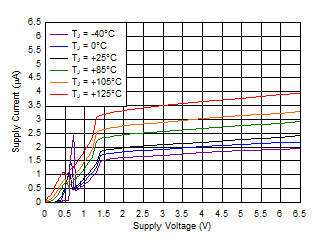
| SENSE1 = SENSE2 = 1.5 V |
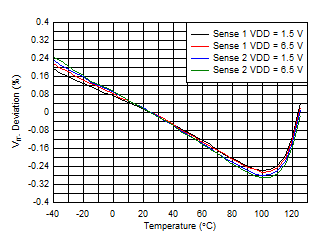
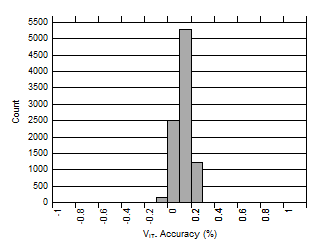
| VDD = 6.5 V |
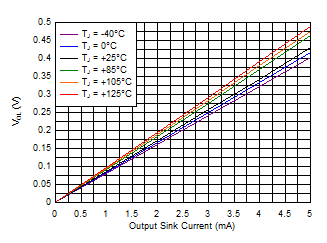
(VDD = 3.3 V)
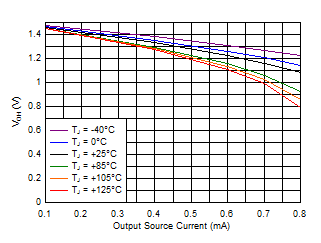
(VDD = 1.5 V)
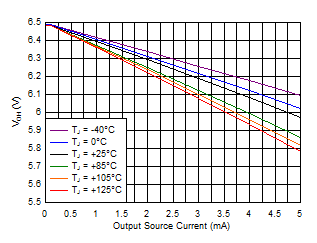
(VDD = 6.5 V)
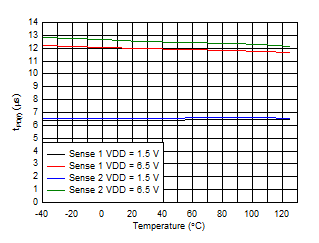
| SENSE1 = SENSE2 = 1.3 V to 0 V |
Sense Low to Output Low
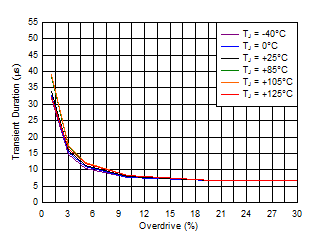
| High-to-low transition occurs above the curve |
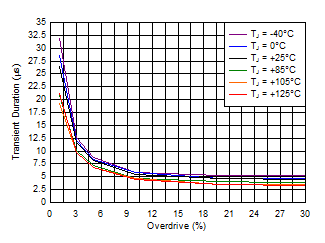
| Low-to-high transition occurs above the curve |
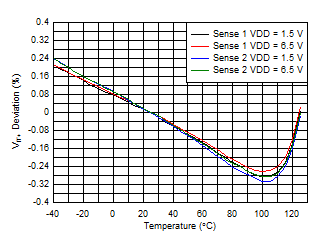
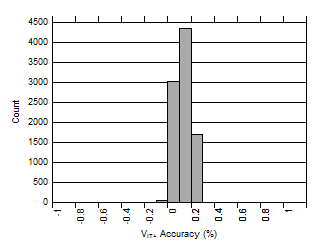
| VDD = 6.5 V |
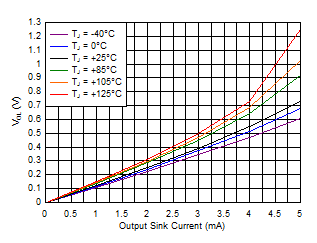
(VDD = 1.5 V)
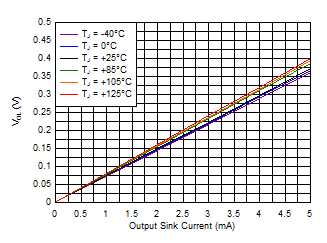
(VDD = 6.5 V)
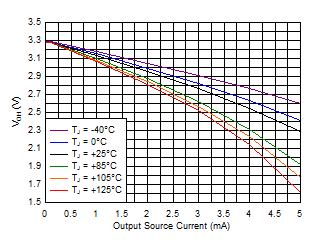
(VDD = 3.3 V)
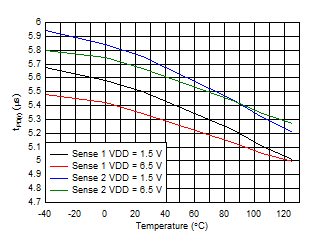
| SENSE1 = SENSE2 = 0 V to 1.3 V |
Sense High to Output High
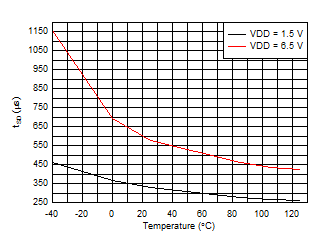
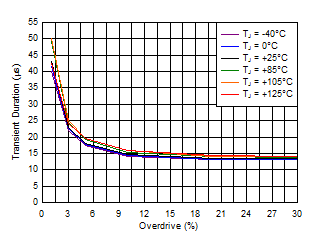
| High-to-low transition occurs above the curve |
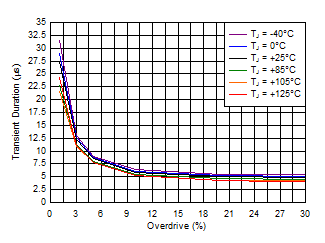
| Low-to-high transition occurs above the curve |